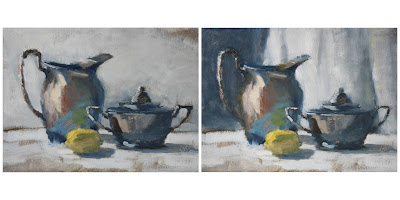 |
| "Lady with an Ermine" Leonardo daVinci, c. 1489 |
 |
| "Patina" 12 x 16, Oil on Linen (c) Lesley Powell 2016 SOLD |
came back to it a few days later, and decided it looked too stark. I pulled out some fabric, and set to work to create a curtained background. You be the judge whether it helped or hurt!
I am not alone in revisiting certain paintings. Recent developments (including reflective light technology) have allowed art historians to look at under-layers of paintings, and it appears that changes of heart are not unusual, even for the great Masters. For example, the top image shows two under-layers of Leonardo Da Vinci's famous "Lady with an Ermine". The final painting, as we know it today, is on the far right. You can see that Da Vinci changed the painting several times. First, he painted the portrait without the ermine. Then with. Then with a different ermine.
In another example, the great French painter Pierre Bonnard used to revise his paintings time and time again, often many years after their "completion". Just above, on the left, you see "The Work Table", which Bonnard painted in 1927. He returned to it again ten years later, and simplified the rug, as you see on the right. I wonder whether that rug had been nagging him for ten years. Or maybe he just happened to see the painting afresh, and had the sudden realization that simplifying the rug would improve the painting.
I have read that on visits to the Luxembourg Museum in Paris, Bonnard would enlist the help of his friend and fellow artist Edouard Vuillard so that he (Bonnard) could make surreptitious touch-ups to his paintings. Vuillard would distract the museum guards, and while they were distracted, Bonnard would pull out his paint box and add a few touches to his paintings that were hanging in the museum. I guess it's true that artists are never really satisfied with their own work--one always believes there is room for improvement!
 |
| "Work Table" Oil on Canvas, 48 x 36 inches Pierre Bonnard, 1926 / 1937 |

No comments:
Post a Comment